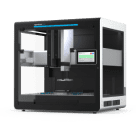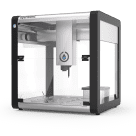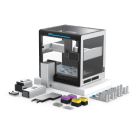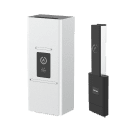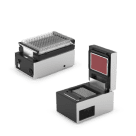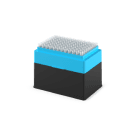Liquid Class Definitions¶
A liquid class definition specifies nearly all transfer behavior a Flex pipette will perform during a InstrumentContext.transfer_with_liquid_class(), InstrumentContext.distribute_with_liquid_class(), or InstrumentContext.consolidate_with_liquid_class(). Properties, like aspirate flow rate, submerge speed, or dispense position, are required in every liquid class definition.
This section details specific changes to transfer behavior for each Opentrons-verified liquid class. The transfer steps are listed in the order the robot performs them. Advanced settings like mix, pre-wet tip, and touch tip are automatically disabled in Opentrons-verified liquid class definitions.
Note
You can customize a liquid class definition for your workflow, either by customizing individual properties of an Opentrons-verified liquid class definition or by creating your own definition from scratch.
For more information, see Customizing Liquid Classes.
To use the tables below, select your liquid class: Aqueous, Viscous, or Volatile. Then, click different tabs to view your pipette and tip combination.
In a liquid class transfer, flow rates and air gap or push out volumes vary based on the pipette and tip combination used in your protocol. Let’s say you use a Flex P1000 1-channel pipette and Flex 200 µL tips to aspirate a volatile liquid. The transfer volume specifies the flow rate:
7 µL/sec to aspirate 5 µL
50 µL/sec to aspirate 50 µL
200 µL/sec to aspirate 200 µL
When your aspirate volume falls in between, like 100 µL, a linear interpolation automatically determines the flow rate.
Aqueous¶
The Opentrons-verified aqueous liquid class is based on deionized water.
Aspirate¶
Behavior |
50 µL |
|---|---|
Submerge speed |
100 mm/sec |
Aspirate flow rate by volume |
|
Correction by volume |
– |
Delay after aspirating |
0.2 sec |
Retract speed |
50 mm/sec |
Delay after retracting |
– |
Air gap by volume |
|
Behavior |
50 µL |
|---|---|
Submerge speed |
100 mm/sec |
Aspirate flow rate by volume |
|
Correction by volume |
– |
Delay after aspirating |
0.2 sec |
Retract speed |
50 mm/sec |
Delay after retracting |
– |
Air gap by volume |
|
Behavior |
50 µL |
200 µL |
1000 µL |
|---|---|---|---|
Submerge speed |
50 mm/sec |
100 mm/sec |
100 mm/sec |
Aspirate flow rate by volume |
|
716 µL/sec |
716 µL/sec |
Correction by volume |
– |
– |
– |
Delay after aspirating |
1.0 sec |
0.75 sec |
0.5 sec |
Retract speed |
50 mm/sec |
50 mm/sec |
50 mm/sec |
Delay after retracting |
– |
– |
– |
Air gap by volume |
|
|
|
Behavior |
50 µL |
200 µL |
1000 µL |
|---|---|---|---|
Submerge speed |
100 mm/sec |
100 mm/sec |
100 mm/sec |
Aspirate flow rate by volume |
|
716 µL/sec |
716 µL/sec |
Correction by volume |
– |
– |
– |
Delay after aspirating |
1.0 sec |
0.75 sec |
0.5 sec |
Retract speed |
50 mm/sec |
50 mm/sec |
50 mm/sec |
Delay after retracting |
– |
– |
– |
Air gap by volume |
|
|
|
Behavior |
50 µL |
200 µL |
|---|---|---|
Submerge speed |
35 mm/sec |
35 mm/sec |
Aspirate flow rate |
6.5 µL/sec |
80 µL/sec |
Correction by volume |
– |
– |
Delay after aspirating |
0.5 sec |
0.75 sec |
Retract speed |
35 mm/sec |
35 mm/sec |
Delay after retracting |
– |
– |
Air gap by volume |
|
|
Behavior |
50 µL |
200 µL |
1000 µL |
|---|---|---|---|
Submerge speed |
35 mm/sec |
35 mm/sec |
35 mm/sec |
Aspirate flow rate |
200 µL/sec |
200 µL/sec |
200 µL/sec |
Correction by volume |
– |
– |
– |
Delay after aspirating |
0.5 sec |
0.75 sec |
0.5 sec |
Retract speed |
35 mm/sec |
35 mm/sec |
35 mm/sec |
Delay after retracting |
– |
– |
– |
Air gap by volume |
|
|
|
Dispense¶
Behavior |
50 µL |
|---|---|
Submerge speed |
100 mm/sec |
Dispense flow rate |
50 µL/sec |
Correction by volume |
– |
Delay after dispensing |
0.2 sec |
Retract speed |
50 mm/sec |
Delay after retracting |
– |
Push out by volume |
|
Air gap by volume |
|
Blow out |
|
Behavior |
50 µL |
|---|---|
Submerge speed |
100 mm/sec |
Dispense flow rate |
50 µL/sec |
Correction by volume |
– |
Delay after dispensing |
0.2 sec |
Retract speed |
50 mm/sec |
Delay after retracting |
– |
Push out by volume |
|
Air gap by volume |
|
Behavior |
50 µL |
200 µL |
1000 µL |
|---|---|---|---|
Submerge speed |
50 mm/sec |
100 mm/sec |
100 mm/sec |
Dispense flow rate by volume |
|
716 µL/sec |
716 µL/sec |
Correction by volume |
– |
– |
– |
Delay after dispensing |
– |
– |
– |
Retract speed |
50 mm/sec |
50 mm/sec |
50 mm/sec |
Delay after retracting |
– |
– |
– |
Push out by volume |
5 µL |
15 µL |
20 µL |
Air gap by volume |
|
|
|
Blow out |
|
– |
– |
Behavior |
50 µL |
200 µL |
1000 µL |
|---|---|---|---|
Submerge speed |
100 mm/sec |
100 mm/sec |
100 mm/sec |
Dispense flow rate by volume |
|
716 µL/sec |
716 µL/sec |
Correction by volume |
– |
– |
– |
Delay after dispensing |
– |
– |
– |
Retract speed |
50 mm/sec |
50 mm/sec |
50 mm/sec |
Delay after retracting |
– |
– |
– |
Push out by volume |
5 µL |
15 µL |
20 µL |
Air gap by volume |
|
|
|
Blow out |
|
– |
– |
Behavior |
50 µL |
200 µL |
|---|---|---|
Submerge speed |
35 mm/sec |
35 mm/sec |
Dispense flow rate |
80 µL/sec |
80 µL/sec |
Correction by volume |
– |
– |
Delay after dispensing |
– |
– |
Retract speed |
35 mm/sec |
35 mm/sec |
Delay after retracting |
– |
– |
Push out by volume |
5 µL |
5 µL |
Air gap by volume |
|
|
Blow out |
|
|
Behavior |
50 µL |
200 µL |
1000 µL |
|---|---|---|---|
Submerge speed |
35 mm/sec |
35 mm/sec |
35 mm/sec |
Dispense flow rate |
200 µL/sec |
200 µL/sec |
200 µL/sec |
Correction by volume |
– |
– |
– |
Delay after dispensing |
– |
– |
– |
Retract speed |
35 mm/sec |
35 mm/sec |
35 mm/sec |
Delay after retracting |
– |
– |
– |
Push out by volume |
20 µL |
15 µL |
20 µL |
Air gap by volume |
|
|
|
Blow out |
– |
– |
– |
Multi-dispense¶
Behavior |
50 µL |
|---|---|
Submerge speed |
100 mm/sec |
Dispense flow rate |
50 µL/sec |
Correction by volume |
– |
Conditioning by volume |
|
Disposal by volume |
|
Delay after dispensing |
– |
Retract speed |
50 mm/sec |
Delay after retracting |
0.2 sec |
Air gap by volume |
|
Blow out |
|
Behavior |
50 µL |
|---|---|
Submerge speed |
100 mm/sec |
Dispense flow rate |
50 µL/sec |
Correction by volume |
– |
Conditioning by volume |
|
Disposal by volume |
|
Delay after dispensing |
0.2 sec |
Retract speed |
50 mm/sec |
Delay after retracting |
– |
Air gap by volume |
|
Blow out |
|
Behavior |
50 µL |
200 µL |
1000 µL |
|---|---|---|---|
Submerge speed |
100 mm/sec |
100 mm/sec |
100 mm/sec |
Dispense flow rate by volume |
|
716 µL/sec |
716 µL/sec |
Correction by volume |
– |
– |
– |
Conditioning by volume |
|
|
|
Disposal by volume |
|
|
|
Delay after dispensing |
– |
– |
– |
Retract speed |
50 mm/sec |
50 mm/sec |
50 mm/sec |
Delay after retracting |
– |
– |
– |
Air gap by volume |
|
|
|
Blow out |
|
|
|
Behavior |
50 µL |
200 µL |
1000 µL |
|---|---|---|---|
Submerge speed |
100 mm/sec |
100 mm/sec |
100 mm/sec |
Dispense flow rate by volume |
|
716 µL/sec |
716 µL/sec |
Correction by volume |
– |
– |
– |
Conditioning by volume |
|
|
|
Disposal by volume |
|
|
|
Delay after dispensing |
– |
– |
– |
Retract speed |
50 mm/sec |
50 mm/sec |
50 mm/sec |
Delay after retracting |
– |
– |
– |
Air gap by volume |
|
|
|
Blow out |
|
|
|
Behavior |
50 µL |
200 µL |
|---|---|---|
Submerge speed |
35 mm/sec |
35 mm/sec |
Dispense flow rate |
80 µL/sec |
200 µL/sec |
Correction by volume |
– |
– |
Conditioning by volume |
|
|
Disposal by volume |
|
|
Delay after dispensing |
– |
– |
Retract speed |
35 mm/sec |
35 mm/sec |
Delay after retracting |
– |
– |
Air gap by volume |
|
|
Blow out |
|
|
Behavior |
50 µL |
200 µL |
1000 µL |
|---|---|---|---|
Submerge speed |
35 mm/sec |
35 mm/sec |
35 mm/sec |
Dispense flow rate |
200 µL/sec |
200 µL/sec |
200 µL/sec |
Correction by volume |
– |
– |
– |
Conditioning by volume |
|
|
|
Disposal by volume |
|
|
|
Delay after dispensing |
– |
– |
– |
Retract speed |
35 mm/sec |
35 mm/sec |
35 mm/sec |
Delay after retracting |
– |
– |
– |
Air gap by volume |
|
|
|
Blow out |
|
|
|
Viscous¶
The Opentrons-verified viscous liquid class is based on 50% glycerol.
Aspirate¶
Behavior |
50 µL |
|---|---|
Submerge speed |
4 mm/sec |
Aspirate flow rate by volume |
|
Correction by volume |
|
Delay after aspirating |
1 sec |
Retract speed |
4 mm/sec |
Delay after retracting |
– |
Air gap by volume |
0 µL |
Behavior |
50 µL |
|---|---|
Submerge speed |
4 mm/sec |
Aspirate flow rate by volume |
|
Correction by volume |
|
Delay after aspirating |
1 sec |
Retract speed |
4 mm/sec |
Delay after retracting |
– |
Air gap by volume |
0 µL |
Behavior |
50 µL |
200 µL |
1000 µL |
|---|---|---|---|
Submerge speed |
4 mm/sec |
4 mm/sec |
4 mm/sec |
Aspirate flow rate by volume |
|
|
|
Correction by volume |
|
|
|
Delay after aspirating |
2 sec |
1 sec |
0.7 sec |
Retract speed |
4 mm/sec |
4 mm/sec |
4 mm/sec |
Delay after retracting |
– |
– |
– |
Air gap |
0 µL |
0 µL |
0 µL |
Behavior |
50 µL |
200 µL |
1000 µL |
|---|---|---|---|
Submerge speed |
4 mm/sec |
4 mm/sec |
4 mm/sec |
Aspirate flow rate by volume |
|
|
|
Correction by volume |
|
|
|
Delay after aspirating |
2 sec |
1 sec |
0.7 sec |
Retract speed |
4 mm/sec |
4 mm/sec |
4 mm/sec |
Delay after retracting |
– |
– |
– |
Air gap |
0 µL |
0 µL |
0 µL |
Behavior |
50 µL |
200 µL |
|---|---|---|
Submerge speed |
10 mm/sec |
10 mm/sec |
Aspirate flow rate by volume |
|
|
Correction by volume |
|
|
Delay after aspirating |
2.0 sec |
1.0 sec |
Retract speed |
10 mm/sec |
10 mm/sec |
Delay after retracting |
– |
– |
Air gap by volume |
0 µL |
0 µL |
Behavior |
50 µL |
200 µL |
1000 µL |
|---|---|---|---|
Submerge speed |
10 mm/sec |
10 mm/sec |
10 mm/sec |
Aspirate flow rate by volume |
|
|
|
Correction by volume |
|
|
|
Delay after aspirating |
2 sec |
1 sec |
0.7 sec |
Retract speed |
10 mm/sec |
10 mm/sec |
10 mm/sec |
Delay after retracting |
– |
– |
– |
Air gap |
0 µL |
0 µL |
0 µL |
Dispense¶
Behavior |
50 µL |
|---|---|
Submerge speed |
4 mm/sec |
Dispense flow rate |
25 µL/sec |
Correction by volume |
|
Delay after dispensing |
0.5 sec |
Retract speed |
4 mm/sec |
Delay after retracting |
– |
Push out by volume |
|
Air gap |
0 µL |
Blow out |
– |
Behavior |
50 µL |
|---|---|
Submerge speed |
4 mm/sec |
Dispense flow rate |
25 µL/sec |
Correction by volume |
|
Delay after dispensing |
0.5 sec |
Retract speed |
4 mm/sec |
Delay after retracting |
– |
Push out by volume |
|
Air gap |
0 µL |
Blow out |
– |
Behavior |
50 µL |
200 µL |
1000 µL |
|---|---|---|---|
Submerge speed |
4 mm/sec |
4 mm/sec |
4 mm/sec |
Dispense flow rate |
50 µL/sec |
50 µL/sec |
250 µL/sec |
Correction by volume |
|
|
|
Delay after dispensing |
1 sec |
0.5 sec |
0.5 sec |
Retract speed |
4 mm/sec |
4 mm/sec |
4 mm/sec |
Delay after retracting |
– |
– |
– |
Push out by volume |
|
20 µL |
35 µL |
Air gap |
0 µL |
0 µL |
0 µL |
Blow out |
– |
– |
– |
Behavior |
50 µL |
200 µL |
1000 µL |
|---|---|---|---|
Submerge speed |
4 mm/sec |
4 mm/sec |
4 mm/sec |
Dispense flow rate |
50 µL/sec |
50 µL/sec |
250 µL/sec |
Correction by volume |
|
|
|
Delay after dispensing |
1 sec |
0.5 sec |
0.5 sec |
Retract speed |
4 mm/sec |
4 mm/sec |
4 mm/sec |
Delay after retracting |
– |
– |
– |
Push out by volume |
|
20 µL |
35 µL |
Air gap |
0 µL |
0 µL |
0 µL |
Blow out |
– |
– |
– |
Behavior |
50 µL |
200 µL |
|---|---|---|
Submerge speed |
10 mm/sec |
10 mm/sec |
Dispense flow rate |
25 µL/sec |
25 µL/sec |
Correction by volume |
|
|
Delay after dispensing |
1.0 sec |
0.5 sec |
Retract speed |
10 mm/sec |
10 mm/sec |
Delay after retracting |
– |
– |
Push out by volume |
|
3.9 µL |
Air gap by volume |
0 µL |
0 µL |
Blow out |
– |
– |
Behavior |
50 µL |
200 µL |
1000 µL |
|---|---|---|---|
Submerge speed |
10 mm/sec |
10 mm/sec |
10 mm/sec |
Dispense flow rate by volume |
|
50 µL/sec |
250 µL/sec |
Correction by volume |
|
|
|
Delay after dispensing |
1 sec |
0.5 sec |
0.5 sec |
Retract speed |
10 mm/sec |
10 mm/sec |
10 mm/sec |
Delay after retracting |
– |
– |
– |
Push out by volume |
|
20 µL |
35 µL |
Air gap |
0 µL |
0 µL |
0 µL |
Blow out |
– |
– |
– |
Multi-dispense¶
Behavior |
50 µL |
|---|---|
Submerge speed |
4 mm/sec |
Dispense flow rate |
25 µL/sec |
Correction by volume |
|
Conditioning by volume |
|
Disposal by volume |
|
Delay after dispensing |
0.5 sec |
Retract speed |
4 mm/sec |
Delay after retracting |
– |
Air gap |
0 µL |
Blow out |
|
Behavior |
50 µL |
|---|---|
Submerge speed |
4 mm/sec |
Dispense flow rate |
25 µL/sec |
Correction by volume |
|
Conditioning by volume |
|
Disposal by volume |
|
Delay after dispensing |
0.5 sec |
Retract speed |
4 mm/sec |
Delay after retracting |
– |
Air gap |
0 µL |
Blow out |
|
Behavior |
50 µL |
200 µL |
1000 µL |
|---|---|---|---|
Submerge speed |
4 mm/sec |
4 mm/sec |
4 mm/sec |
Dispense flow rate |
50 µL/sec |
50 µL/sec |
250 µL/sec |
Correction by volume |
|
|
|
Conditioning by volume |
|
|
|
Disposal by volume |
|
|
|
Delay after dispensing |
1 sec |
0.5 sec |
0.5 sec |
Retract speed |
4 mm/sec |
4 mm/sec |
4 mm/sec |
Delay after retracting |
– |
– |
– |
Air gap |
0 µL |
0 µL |
0 µL |
Blow out |
|
|
|
Behavior |
50 µL |
200 µL |
1000 µL |
|---|---|---|---|
Submerge speed |
4 mm/sec |
4 mm/sec |
4 mm/sec |
Dispense flow rate |
50 µL/sec |
50 µL/sec |
250 µL/sec |
Correction by volume |
|
|
|
Conditioning by volume |
|
|
|
Disposal by volume |
|
|
|
Delay after dispensing |
1 sec |
0.5 sec |
0.5 sec |
Retract speed |
4 mm/sec |
4 mm/sec |
4 mm/sec |
Delay after retracting |
– |
– |
– |
Air gap |
0 µL |
0 µL |
0 µL |
Blow out |
|
|
|
Behavior |
50 µL |
200 µL |
|---|---|---|
Submerge speed |
10 mm/sec |
10 mm/sec |
Dispense flow rate by volume |
|
50 µL/sec |
Correction by volume |
|
|
Conditioning by volume |
|
|
Disposal by volume |
|
|
Delay after dispensing |
1.0 sec |
0.5 sec |
Retract speed |
10 mm/sec |
10 mm/sec |
Delay after retracting |
– |
– |
Air gap by volume |
0 µL |
0 µL |
Blow out |
|
|
Behavior |
50 µL |
200 µL |
1000 µL |
|---|---|---|---|
Submerge speed |
10 mm/sec |
10 mm/sec |
10 mm/sec |
Dispense flow rate by volume |
|
50 µL/sec |
250 µL/sec |
Correction by volume |
|
|
|
Conditioning by volume |
|
|
|
Disposal by volume |
|
|
|
Delay after dispensing |
1 sec |
0.5 sec |
0.5 sec |
Retract speed |
10 mm/sec |
10 mm/sec |
10 mm/sec |
Delay after retracting |
– |
– |
– |
Air gap |
0 µL |
0 µL |
0 µL |
Blow out |
|
|
|
Volatile¶
The Opentrons-verified volatile liquid class is based on 80% ethanol.
Aspirate¶
Behavior |
50 µL |
|---|---|
Submerge speed |
100 mm/sec |
Aspirate flow rate by volume |
|
Correction by volume |
|
Delay after aspirating |
0.2 sec |
Retract speed |
100 mm/sec |
Delay after retracting |
0.5 sec |
Air gap by volume |
|
Behavior |
50 µL |
|---|---|
Submerge speed |
100 mm/sec |
Aspirate flow rate by volume |
|
Correction by volume |
|
Delay after aspirating |
0.2 sec |
Retract speed |
100 mm/sec |
Delay after retracting |
0.5 sec |
Air gap by volume |
|
Behavior |
50 µL |
200 µL |
1000 µL |
|---|---|---|---|
Submerge speed |
100 mm/sec |
100 mm/sec |
100 mm/sec |
Aspirate flow rate by volume |
|
|
|
Correction by volume |
|
|
|
Delay after aspirating |
0.2 sec |
0.2 sec |
0.2 sec |
Retract speed |
100 mm/sec |
100 mm/sec |
100 mm/sec |
Delay after retracting |
0.5 sec |
0.5 sec |
0.5 sec |
Air gap by volume |
|
|
|
Behavior |
50 µL |
200 µL |
1000 µL |
|---|---|---|---|
Submerge speed |
100 mm/sec |
100 mm/sec |
100 mm/sec |
Aspirate flow rate by volume |
|
|
|
Correction by volume |
|
|
|
Delay after aspirating |
0.2 sec |
0.2 sec |
0.2 sec |
Retract speed |
100 mm/sec |
100 mm/sec |
100 mm/sec |
Delay after retracting |
0.5 sec |
0.5 sec |
0.5 sec |
Air gap by volume |
|
|
|
Behavior |
50 µL |
200 µL |
|---|---|---|
Submerge speed |
35 mm/sec |
35 mm/sec |
Aspirate flow rate by volume |
|
|
Correction by volume |
|
|
Conditioning by volume |
|
|
Disposal by volume |
|
|
Delay after aspirating |
– |
0.2 sec |
Retract speed |
35 mm/sec |
35 mm/sec |
Delay after retracting |
0.2 sec |
0.5 sec |
Air gap by volume |
|
|
Behavior |
50 µL |
200 µL |
1000 µL |
|---|---|---|---|
Submerge speed |
35 mm/sec |
35 mm/sec |
35 mm/sec |
Aspirate flow rate by volume |
|
|
|
Correction by volume |
|
|
|
Delay after aspirating |
0.2 sec |
0.2 sec |
0.2 sec |
Retract speed |
35 mm/sec |
35 mm/sec |
100 mm/sec |
Delay after retracting |
0.5 sec |
0.5 sec |
0.5 sec |
Air gap by volume |
|
|
|
Dispense¶
Behavior |
50 µL |
|---|---|
Submerge speed |
100 mm/sec |
Dispense flow rate |
30 µL/sec |
Correction by volume |
|
Delay after dispensing |
0.2 sec |
Retract speed |
100 mm/sec |
Delay after retracting |
0.5 sec |
Push out by volume |
1.0µL |
Air gap by volume |
|
Behavior |
50 µL |
|---|---|
Submerge speed |
100 mm/sec |
Dispense flow rate |
30 µL/sec |
Correction by volume |
|
Delay after dispensing |
0.2 sec |
Retract speed |
100 mm/sec |
Delay after retracting |
0.5 sec |
Push out by volume |
1.0 µL |
Air gap by volume |
|
Behavior |
50 µL |
200 µL |
1000 µL |
|---|---|---|---|
Submerge speed |
100 mm/sec |
100 mm/sec |
100 mm/sec |
Dispense flow rate |
125 µL/sec |
125 µL/sec |
250 µL/sec |
Correction by volume |
|
|
|
Delay after dispensing |
0.2 sec |
0.2 sec |
0.2 sec |
Retract speed |
100 mm/sec |
100 mm/sec |
100 mm/sec |
Delay after retracting |
0.5 sec |
0.5 sec |
0.5 sec |
Push out by volume |
|
|
|
Air gap by volume |
|
|
|
Behavior |
50 µL |
200 µL |
1000 µL |
|---|---|---|---|
Submerge speed |
100 mm/sec |
100 mm/sec |
100 mm/sec |
Dispense flow rate |
125 µL/sec |
125 µL/sec |
250 µL/sec |
Correction by volume |
|
|
|
Delay after dispensing |
0.2 sec |
0.2 sec |
0.2 sec |
Retract speed |
100 mm/sec |
100 mm/sec |
100 mm/sec |
Delay after retracting |
0.5 sec |
0.5 sec |
0.5 sec |
Push out by volume |
|
|
|
Air gap by volume |
|
|
|
Behavior |
50 µL |
200 µL |
|---|---|---|
Submerge speed |
35 mm/sec |
35 mm/sec |
Dispense flow rate |
|
|
Correction by volume |
|
|
Conditioning by volume |
|
|
Disposal by volume |
|
|
Delay after dispensing |
0.2 sec |
0.2 sec |
Retract speed |
35 mm/sec |
35 mm/sec |
Delay after retracting |
0.5 sec |
0.5 sec |
Push out by volume |
0 µL |
0 µL |
Air gap by volume |
|
|
Blow out |
– |
– |
Behavior |
50 µL |
200 µL |
1000 µL |
|---|---|---|---|
Submerge speed |
35 mm/sec |
35 mm/sec |
35 mm/sec |
Dispense flow rate |
125 µL/sec |
200 µL/sec |
250 µL/sec |
Correction by volume |
|
|
|
Delay after dispensing |
0.2 sec |
0.2 sec |
0.2 sec |
Retract speed |
35 mm/sec |
35 mm/sec |
100 mm/sec |
Delay after retracting |
0.5 sec |
0.5 sec |
0.5 sec |
Push out by volume |
|
|
|
Air gap by volume |
|
|
|
Multi-dispense¶
Behavior |
50 µL |
|---|---|
Submerge speed |
100 mm/sec |
Dispense flow rate |
30 µL/sec |
Correction by volume |
|
Conditioning by volume |
|
Disposal by volume |
|
Delay after dispensing |
0.2 sec |
Retract speed |
100 mm/sec |
Delay after retracting |
0.5 sec |
Air gap by volume |
|
Behavior |
50 µL |
|---|---|
Submerge speed |
100 mm/sec |
Dispense flow rate |
30 µL/sec |
Correction by volume |
|
Conditioning by volume |
|
Disposal by volume |
|
Delay after dispensing |
0.2 sec |
Retract speed |
100 mm/sec |
Delay after retracting |
0.5 sec |
Air gap by volume |
|
Behavior |
50 µL |
200 µL |
1000 µL |
|---|---|---|---|
Submerge speed |
100 mm/sec |
100 mm/sec |
100 mm/sec |
Dispense flow rate |
125 µL/sec |
125 µL/sec |
250 µL/sec |
Correction by volume |
|
|
|
Conditioning by volume |
|
|
|
Disposal by volume |
|
|
|
Delay after dispensing |
0.2 sec |
0.2 sec |
0.2 sec |
Retract speed |
100 mm/sec |
100 mm/sec |
100 mm/sec |
Delay after retracting |
0.5 sec |
0.5 sec |
0.5 sec |
Air gap by volume |
|
|
|
Behavior |
50 µL |
200 µL |
1000 µL |
|---|---|---|---|
Submerge speed |
100 mm/sec |
100 mm/sec |
100 mm/sec |
Dispense flow rate |
125 µL/sec |
125 µL/sec |
250 µL/sec |
Correction by volume |
|
|
|
Conditioning by volume |
|
|
|
Disposal by volume |
|
|
|
Delay after dispensing |
0.2 sec |
0.2 sec |
0.2 sec |
Retract speed |
100 mm/sec |
100 mm/sec |
100 mm/sec |
Delay after retracting |
0.5 sec |
0.5 sec |
0.5 sec |
Air gap by volume |
|
|
|
Behavior |
50 µL |
200 µL |
|---|---|---|
Submerge speed |
35 mm/sec |
35 mm/sec |
Dispense flow rate |
100 µL/sec |
100 µL/sec |
Correction by volume |
|
|
Conditioning by volume |
|
|
Disposal by volume |
|
|
Delay after dispensing |
2.0 sec |
1.0 sec |
Retract speed |
35 mm/sec |
35 mm/sec |
Delay after retracting |
0.5 sec |
0.5 sec |
Air gap by volume |
|
|
Blow out |
|
|
Behavior |
50 µL |
200 µL |
1000 µL |
|---|---|---|---|
Submerge speed |
35 mm/sec |
35 mm/sec |
100 mm/sec |
Dispense flow rate |
125 µL/sec |
200 µL/sec |
250 µL/sec |
Correction by volume |
|
|
|
Conditioning by volume |
|
|
|
Disposal by volume |
|
|
|
Delay after dispensing |
0.2 sec |
0.2 sec |
0.2 sec |
Retract speed |
35 mm/sec |
35 mm/sec |
100 mm/sec |
Delay after retracting |
0.5 sec |
0.5 sec |
0.5 sec |
Air gap by volume |
|
|
|


